As you walked along the trail through Explore the Wild on your last visit to the Museum, you may have noticed tiny “wet” spots on the pavement on the north side of the Wetlands and again past the Lemur House on your way to Catch the Wind, as if it had been lightly raining. If, when you saw the “wet” spots, you looked up you would have seen a branch of a mimosa tree above you. The wet spots came from the tree. But wait, they didn’t actually come from the tree but from tiny animals on the leaves and stems of the tree.
I’ve noticed this phenomenon each year that I’ve been here at the Museum. I at first assumed that the cause of the wet spots was aphids, a valid assumption. Aphids, leafhoppers, and some other plant sucking insects produce honeydew. Besides coating the leaves with the sticky substance, the honeydew rains down to the ground. I’ve seen areas where the honeydew rained down in such quantity that it looked to be actually raining, all produced by leafhoppers.
In the case of the mimosa trees, a black mold grows on the honeydew which turns the leaves of the tree blackish, and apparently, the pavement on which the honeydew falls (wet spots).
Many insects are attracted to the trees because of the honeydew, including ants, bees and wasps (for the honeydew), and lady beetles (to eat the insects that produce the honeydew).
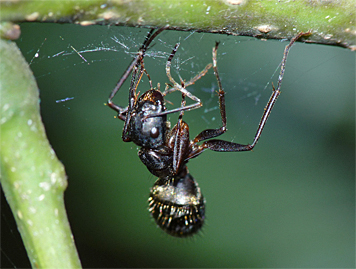
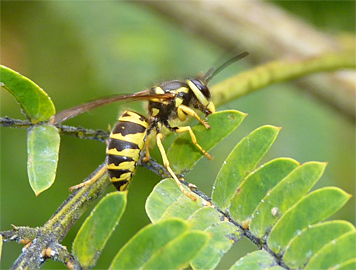
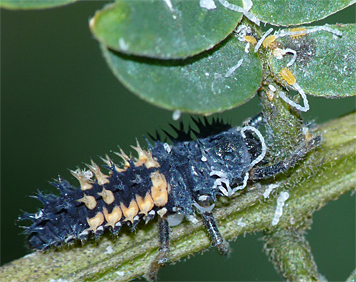
Golden-crowned Kinglets eat insects. After watching several kinglets feeding heavily on mimosa, and wondering exactly what it was that they were feeding on, I decided to find out. I knew that there were plenty of insects on these mimosas, but what exactly were the kinglets after?
One of my first discoveries was that it was not an aphid, or aphids, that was producing the honeydew as I had assumed, but psyllids (tiny orange-yellow specs in the photos above and below). Like aphids, psyllids suck plant juices. These tiny insects also produce honeydew (on which blackish, sooty mold grows) and a white, waxy substance as well.
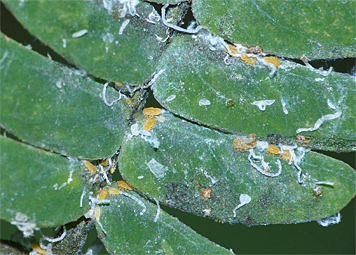
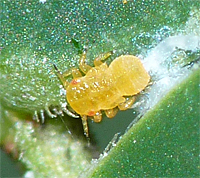
As stated, the nymphs produce a waxy tubular structure from their rear ends to direct honeydew away from themselves as they eat and slowly move about. You have to look closely to see the tiny (<1 mm), orange-colored creatures, but their waxy tubular excretion tubes are usually evident.
There can be hundreds, possibly thousands, of psyllids on one of the tree’s leaves (mimosa trees have compound bipinnate leaves meaning that the leaves are divided into leaflets, and again into subleaflets – the yellowjacket above is grasping a subleaflet with its front two pair of legs). On one leaf I counted 3 lady beetle larvae. Some leaves had no lady beetle larvae. I only saw one ant on any given leaf, when there was an ant present. Bees and wasps were coming and going. I never saw more than one or two at a time on any leaf.
The kinglets that I had observed had been working over the leaves methodically, concentrating on one leaf at a time, pecking at it from above and below almost constantly. Whatever it was that they were gleaning from the leaves appeared to be quite numerous. The most numerous insects on the leaves that I examined were psyllids (as mentioned, you have to look very closely to see them).
I don’t know for sure what the kinglets were eating while foraging on the mimosa trees, but judging by the frequency with which they pecked at the foliage I’d bet on the psyllids. And, short of collecting one of the little birds and checking its stomach contents (which would be illegal, and not very respectful of the kinglets) I’d say the psyllids are a safe bet. Kinglets have been recorded eating aphids as well as psyllids. Kinglets, both species, are tiny birds with thin pointed bills made just for that purpose, to glean small insects from trees, shrubs and other vegetaion. I suspect though, that when they come across a lady beetle larva, they scoffed that up as well.
More than a week has past since the photos above were taken. Yesterday (10/21), as I walked through Explore the Wild there were many Yellow-rumped Warblers and at least one Prairie Warbler present. I watched as several Yellow-rumps and the Prairie foraged through the mimosas, they too were feverishly pecking away at what was on the foliage of the trees in much the same manner as the kinglets had. I’m sure they were also enjoying the psyllids. I did, however, see the Prairie Warbler pick up and swallow something large enough, and dark enough, to be a lady beetle larva.
Bon appetit!
Thank you for this interesting article !